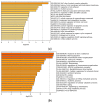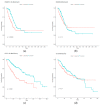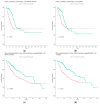Examination of Independent Prognostic Power of Gene Expressions and Histopathological Imaging Features in Cancer
- PMID: 30871256
- PMCID: PMC6468814
- DOI: 10.3390/cancers11030361
Examination of Independent Prognostic Power of Gene Expressions and Histopathological Imaging Features in Cancer
Abstract
Cancer prognosis is of essential interest, and extensive research has been conducted searching for biomarkers with prognostic power. Recent studies have shown that both omics profiles and histopathological imaging features have prognostic power. There are also studies exploring integrating the two types of measurements for prognosis modeling. However, there is a lack of study rigorously examining whether omics measurements have independent prognostic power conditional on histopathological imaging features, and vice versa. In this article, we adopt a rigorous statistical testing framework and test whether an individual gene expression measurement can improve prognosis modeling conditional on high-dimensional imaging features, and a parallel analysis is conducted reversing the roles of gene expressions and imaging features. In the analysis of The Cancer Genome Atlas (TCGA) lung adenocarcinoma and liver hepatocellular carcinoma data, it is found that multiple individual genes, conditional on imaging features, can lead to significant improvement in prognosis modeling; however, individual imaging features, conditional on gene expressions, only offer limited prognostic power. Being among the first to examine the independent prognostic power, this study may assist better understanding the "connectedness" between omics profiles and histopathological imaging features and provide important insights for data integration in cancer modeling.
Keywords: cancer prognosis; histopathological imaging features; independent prognostic power; omics profiles.
Conflict of interest statement
The authors declare no conflict of interest.
Figures




Similar articles
-
Detecting Prognosis Risk Biomarkers for Colon Cancer Through Multi-Omics-Based Prognostic Analysis and Target Regulation Simulation Modeling.Front Genet. 2020 May 26;11:524. doi: 10.3389/fgene.2020.00524. eCollection 2020. Front Genet. 2020. PMID: 32528533 Free PMC article.
-
Histopathological imaging features- versus molecular measurements-based cancer prognosis modeling.Sci Rep. 2020 Sep 14;10(1):15030. doi: 10.1038/s41598-020-72201-5. Sci Rep. 2020. PMID: 32929170 Free PMC article.
-
Histopathological Images and Multi-Omics Integration Predict Molecular Characteristics and Survival in Lung Adenocarcinoma.Front Cell Dev Biol. 2021 Oct 11;9:720110. doi: 10.3389/fcell.2021.720110. eCollection 2021. Front Cell Dev Biol. 2021. PMID: 34708036 Free PMC article.
-
Predicting censored survival data based on the interactions between meta-dimensional omics data in breast cancer.J Biomed Inform. 2015 Aug;56:220-8. doi: 10.1016/j.jbi.2015.05.019. Epub 2015 Jun 3. J Biomed Inform. 2015. PMID: 26048077 Free PMC article.
-
Integrative data mining and meta-analysis to investigate the prognostic role of microRNA-200 family in various human malignant neoplasms: A consideration on heterogeneity.Gene. 2019 Oct 20;716:144025. doi: 10.1016/j.gene.2019.144025. Epub 2019 Aug 5. Gene. 2019. PMID: 31394177 Review.
Cited by
-
Multiomics and machine learning in lung cancer prognosis.J Thorac Dis. 2020 Aug;12(8):4531-4535. doi: 10.21037/jtd-2019-itm-013. J Thorac Dis. 2020. PMID: 32944369 Free PMC article. No abstract available.
-
HETEROGENEITY ANALYSIS VIA INTEGRATING MULTI-SOURCES HIGH-DIMENSIONAL DATA WITH APPLICATIONS TO CANCER STUDIES.Stat Sin. 2023 Apr;33(2):729-758. doi: 10.5705/ss.202021.0002. Stat Sin. 2023. PMID: 38037567 Free PMC article.
-
Clustering on hierarchical heterogeneous data with prior pairwise relationships.BMC Bioinformatics. 2024 Jan 23;25(1):40. doi: 10.1186/s12859-024-05652-6. BMC Bioinformatics. 2024. PMID: 38262930 Free PMC article.
-
Integrative Analysis of Histopathological Images and Genomic Data in Colon Adenocarcinoma.Front Oncol. 2021 Sep 27;11:636451. doi: 10.3389/fonc.2021.636451. eCollection 2021. Front Oncol. 2021. PMID: 34646756 Free PMC article.
-
Histopathological image and gene expression pattern analysis for predicting molecular features and prognosis of head and neck squamous cell carcinoma.Cancer Med. 2021 Jul;10(13):4615-4628. doi: 10.1002/cam4.3965. Epub 2021 May 13. Cancer Med. 2021. PMID: 33987946 Free PMC article.
References
-
- Rath M.G., Uhlmann L., Fiedler M., Heil J., Golatta M., Dinkic C., Hennigs A., Schott S., Ernst V., Koch T., et al. Oncotype DX((R)) in breast cancer patients: Clinical experience, outcome and follow-up-a case-control study. Arch. Gynecol. Obstet. 2018;297:443–447. doi: 10.1007/s00404-017-4618-z. - DOI - PubMed
-
- Muller H.M., Widschwendter A., Fiegl H., Ivarsson L., Goebel G., Perkmann E., Marth C., Widschwendter M. DNA methylation in serum of breast cancer patients: An independent prognostic marker. Cancer Res. 2003;63:7641–7645. - PubMed
Grants and funding
LinkOut - more resources
Full Text Sources
Molecular Biology Databases

